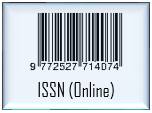Synthesis of Silver Nanoparticles Using Premna serratifolia Linn. Leaf Extract as Reducing Agent and Their Antibacterial Activity
(1) Master Program of Chemistry, Faculty of Mathematics and Natural Sciences, Universitas Tanjungpura, Jl. Prof. Dr. H. Hadari Nawawi, Pontianak 78124, Indonesia
(2) Department of Chemistry, Faculty of Mathematics and Natural Sciences, Universitas Tanjungpura, Jl. Prof. Dr. H. Hadari Nawawi, Pontianak 78124, Indonesia
(3) Department of Chemistry, Faculty of Mathematics and Natural Sciences, Universitas Tanjungpura, Jl. Prof. Dr. H. Hadari Nawawi, Pontianak 78124, Indonesia
(*) Corresponding Author
Abstract
Keywords
Full Text:
PDFReferences
Agnihotri, S., Mukherji, S., Mukherji, S., 2014. Size-controlled silver nanoparticles synthesized over the range 5-100 nm using the same protocol and their antibacterial efficacy. RSC Advances, 4(8), 3974–3983.
Ahmad, S., Munir, S., Zeb, N., Ullah, A., Ali, J., Bilal, M., Omer, M., Alamzeb, M., Salman, S.M., Ali, S., 2019. Green nanotechnology: a review on green synthesis of silver nanoparticles — An ecofriendly approach. International Journal of Nanomedicine, 14, 5087–5107.
Annadhasan, M., Muthukumarasamyvel, T., Sankar Babu, V.R., Rajendiran, N., 2014. Green synthesized silver and gold nanoparticles for colorimetric detection of Hg2+, Pb2+, and Mn2+ in aqueous medium. ACS Sustainable Chemistry and Engineering, 2(4), 887–896.
Bhattacharjee, S., 2016. DLS and Zeta potential: what they are and what they are not? Journal of Controlled Release, 235, 337–351.
Chandra, H., Kumari, P., Bontempi, E., Yadav, S., 2020. Medicinal plants: treasure trove for green synthesis of metallic nanoparticles and their biomedical applications. Biocatalysis and Agricultural Biotechnology, 24(101518), 1–11.
Dachriyanus, 2004. Analisis struktur senyawa organik secara spektroskopi. Lembaga Pengembangan Teknologi Informasi dan Komunikasi Universitas Andalas, Padang.
Das, C.G.A., Kumar, V.G., Dhas, T.S., Karthick, V., Govindaraju, K., Joselin, J.M., Baalamurugan, J., 2020. Antibacterial activity of silver nanoparticles (biosynthesis): a short review on recent advances. Biocatalysis and Agricultural Biotechnology, 27(101593).
Gusrizal, G., Santosa, S.J., Kunarti, E.S., Rusdiarso, B., 2018. Two highly stable silver nanoparticles: surface plasmon resonance spectra study of silver nanoparticles capped with m-Hydroxybenzoic acid and p-hydroxybenzoic acid. Molekul, 13(1), 30–37.
Gusrizal, G., Santosa, S.J., Kunarti, E.S., Rusdiarso, B., 2017. Synthesis of silver nanoparticles by reduction of silver ion with m-Hydroxybenzoic acid. Asian Journal of Chemistry, 29(7), 1417–1422.
Hashemi, S.F., Tasharrofi, N., Saber, M.M., 2020. Green synthesis of silver nanoparticles using Teucrium polium leaf extract and assessment of their antitumor effects against MNK45 human gastric cancer cell line. Journal of Molecular Structure, 1208, 127889.
Hemlata, Meena, P.R., Singh, A.P., Tejavath, K.K., 2020. Biosynthesis of silver nanoparticles using Cucumis prophetarum aqueous leaf extract and their antibacterial and antiproliferative activity against cancer cell lines. ACS Omega, 5, 5520–5528.
Isnindar, I., Luliana, S., 2020. Synergism of antioxidant activity combination of Buas-Buas (Premnaserratifolia Linn.), Meniran (Phyllanthusniruri L.), Secang (Caesalpiniasappan) and Roselle (Hibiscus sabdarifa) extracts. Traditional Medicine Journal, 25(3), 138–143.
Jadhav, K., Deore, S., Dhamecha, D., Hr, R., Jagwani, S., Jalalpure, S., Bohara, R., 2018. Phytosynthesis of silver nanoparticles: characterization, biocompatibility studies, and anticancer activity. ACS Biomaterials Science and Engineering, 4(3), 892–899.
Le Ouay, B., Stellacci, F., 2015. Antibacterial activity of silver nanoparticles: a surface science insight. Nano Today, 10(3), 339–354.
Marambio-Jones, C., Hoek, E.M.V., 2010. A review of the antibacterial effects of silver nanomaterials and potential implications for human health and the environment. Journal of Nanoparticle Research, 12(5), 1531–1551.
Octavianus, C., 2021. Sintesis nanopartikel perak dengan reduktor ekstrak daun Buas-Buas (Premna serratifolia Linn.) dan uji aktivitasnya sebagai antibakteri. Universitas Tanjungpura.
Purwanti, N.U., Wahdiyanti, R., Susanti, R., 2018. Effect of variation of solvent concentration to antioxidant activity of ethanolic extract of Buas-Buas stem (Premna serratifolia L.) using DPPH (2, 2-diphenyl-1 picrylhidrazyl) scavenging method, in: Ningrum, V.D.A. (Ed.), International Conference on Pharmaceutical Research and Practice. Department of Pharmacy, Universitas Islam Indonesia, Yogyakarta, 126–132.
Ravichandran, V., Vasanthi, S., Shalini, S., Shah, S.A.A., Tripathy, M., Paliwal, N., 2019. Green synthesis, characterization, antibacterial, antioxidant and photocatalytic activity of Parkia speciosa leaves extract mediated silver nanoparticles. Results in Physics, 15, 102565.
Sharma, V.K., Yngard, R.A., Lin, Y., 2009. Silver nanoparticles: green synthesis and their antimicrobial activities. Advances in Colloid and Interface Science, 145(1–2), 83–96.
Srikar, S.K., Giri, D.D., Pal, D.B., Mishra, P.K., Upadhyay, S.N., 2016. Green synthesis of silver nanoparticles: a review. Green and Sustainable Chemistry, 6, 34–56.
Xu, Z., Zhang, C., Wang, X., Liu, D., 2021. Release strategies of silver ions from materials for bacterial killing. ACS Applied Bio Materials, 4(5), 3985–3999.
DOI: https://doi.org/10.24071/jpsc.003185
Refbacks
- There are currently no refbacks.
Copyright (c) 2022 Jurnal Farmasi Sains dan Komunitas (Journal of Pharmaceutical Sciences and Community)
Jurnal Farmasi Sains dan Komunitas (Journal of Pharmaceutical Sciences and Community)
Published by Faculty of Pharmacy, Universitas Sanata Dharma Yogyakarta

This work is licensed under a Creative Commons Attribution 4.0 International License.













.png)













